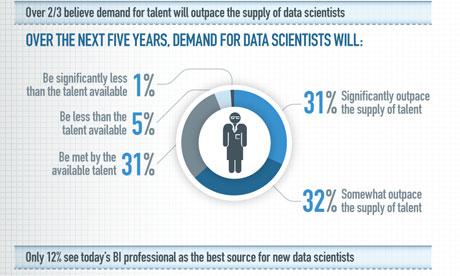Every
day we come across articles, columns or blogs about Big Data in some newspaper,
magazine or management journal. Authors, like on our blog, praise its
advantages and demonstrate concrete scenarios and situations where Big Data can
improve things for the better. But the question we should ask ourselves is: Are
we ready to handle Big Data?
Research
Company Gartner predicts that 4.4 million new jobs in the field of Big Data
will be created worldwide by 2015. Despite that fact, McKinsey & Company in
one of their reports recently revealed that they expect a shortage of up to
190,000 data scientists and 1.5 million managers with capabilities to use Big
Data successfully by 2018. This insight is dramatic considering that
data-driven companies on average show a significantly superior performance in
many benchmarking studies. So how can companies, individuals and countries
prepare themselves for this new era of data?
Universities around the world are
jumping on the new trend and offer courses in Big Data. My own Alma Mater, IE
Business School, recently introduced an Elective in the MBA about Big Data.
Other schools like Columbia University have used additional funding to
establish a new institutes in this field that offer several courses around Big
Data and would eventually provide entire Master degrees to interested students.
Similar Masters Degrees are being offered by George Washington University, NYU
and Schulich Business School. Universities are trying to fill the gap by offering
relevant courses to potential students. Nevertheless,
the scale of available Big Data education is by far too little yet and
traditional business schools will find it difficult to say goodbye to their
preferred case study methodology, which is less adequate to teach Big Data.
Companies on
the other hand try to compensate for the trend by hiring legions of consultants
from IBM, Accenture and Co. to participate in this new development and to bring
new knowledge to their organizations. Despite short-term impact, it is not rare
though that these kind of initiatives lose traction once the consultants leave after
handing over the initiative to employees. This may be due to pure lack of
skills on part of employees. The failure of such an initiative may be
attributed to corporate cultures, which may not be data-driven per se. A change
in culture is a required to encourage employees to use data to address business
issues. Companies therefore should never lose focus to build strong in-house
capabilities about Big Data and to change the culture from the top to a more
data-driven organization that empowers employees to take decisions based on
data rather than rigid rules.
It
is clear that not every individual can leave work and study full-time now to
become proficient in Big Data. Individuals interested in Big Data can use free
online courses available on platforms like Coursera or Open2Study.
In addition, they could join pilot projects in their direct surroundings to
gain experience in this new field of business.
Lastly, if
you are still not convinced that looking into Big Data might be worth it, the
average annual salary for data scientists in the U.S. is $80,000 to $220,000
based on the website www.glassdoor.com.
Not bad for a bunch of geeks that by now seem to be seen more and more on main
street.







